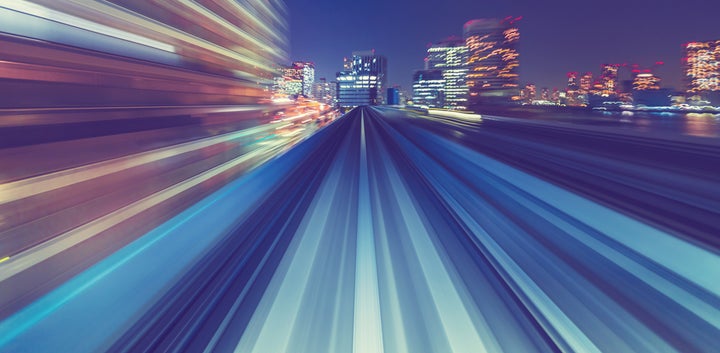
Abstract high speed technology POV motion blurred concept image from the Yuikamome monorail in Tokyo Japan Image ID:370236977
Picture the commute of the future: You live in Palo Alto, Calif., but work 350 miles away in Los Angeles. After your morning latte, you click on a smartphone app to summon your digital chauffeur. An autonomous car shows up at your front door three minutes later to drive you to a Hyperloop station in downtown Mountain View, where a pod then transports you through a vacuum tube at 760 mph. When you reach the Pasadena station, another self-driving car awaits to take you to your office. You reach your destination in less than an hour.
That is the type of scenario that Hyperloop Transportation Technologies (HTT) chief executive Dirk Ahlborn laid out for me as we were preparing to speak together on a panel at the Knowledge Summit in Dubai on Dec. 5. He was not talking about something that would happen in the next century; he expects the first of these systems to be operational in the United Arab Emirates by 2020. The Abu Dhabi government has just announced that it has been working with his company to connect Abu Dhabi and Al Ain, two UAE cities separated by 105 miles, using the Hyperloop system.
A proposal for this mode of transportation came from Elon Musk in August 2013, in a paper titled “Hyperloop Alpha.” Musk envisaged a mass transit system in which trains travel as fast as 760 mph in pressurized capsule pods. These would ride on an air cushion in steel tubes and be driven by linear induction motors and air compressors. He claimed that the system would be safer, faster and cheaper than trains, cars boats and supersonic planes, for distances of up to at least 900 miles, and said that it would be resistant to earthquakes and generate more energy through its solar panels than it would use.
Straight out of science fiction it may be, but two start-ups took up Musk’s challenge to develop the technology: HTT and Hyperloop One. These companies have raised more than $100 million each and say they will have operational systems in three to four years and that they have governments backing them. Hyperloop One demonstrated elements of the technology in the Las Vegas desert in May 2016. The sheiks I spoke with in Dubai were most excited about HTT’s system.
Even if the Hyperloop technology doesn’t pan out, the digital chauffeurs surely are coming. Self-driving cars such as the Tesla that I drive can already take control of the wheel on highways and are able to monitor traffic around them better than humans can — because their sensors enable them to see in 360 degrees and communicate with each other to negotiate rights of way.
By 2020, self-driving cars will have progressed so far that they can drive safely at speeds as fast as 200 mph in their own partitioned lanes on highways. In these circumstances, the commute to Los Angeles from San Francisco would take only an hour and a half — without the need to catch a connection to a supersonic pod. From Abu Dhabi to Al Ain or Dubai could take the car 30 to 40 minutes, door to door. In other words, Elon Musk’s self-driving cars and HTT’s short-haul Hyperloops may be competing with each other. I’m one of those who would prefer the convenience of having their car come with them so that they can keep extra stuff in the back and be working uninterrupted on the commute. In any case, for longer journeys, say from New York or San Francisco to Miami, catching a Hyperloop will make more sense than riding in the self-driving car.
The point, though, is that we are on the verge of a revolution in transportation. For decades — actually, centuries — we have been dependent on locomotives and, more recently, airplanes to take us long distances. The technologies have hardly advanced. The entire industry is about to be disrupted. Many of us will choose to take the shared cars and Hyperloops; others will own their own cars. But we will take fewer rides in trains and planes.
That is why new rail-based transportation systems, such as the one that California has long been debating, are not sensible investments to make. By the time they are complete, our modes of mass transportation will have changed. The California project aims to move 20 to 24 million passengers a year from downtown L.A. to downtown San Francisco, through California’s Central Valley, in 2 hours 40 minutes. It is projected to cost an estimated $64 billion when completed by about 2030. By then, we will be debating whether human beings should be allowed to drive cars, and public rail systems will be facing bankruptcy because of cheaper and better alternatives.
The wise investment to make will be in accelerating adoption of self-driving cars and in reserving lanes for them, and in building energy-efficient long-distance transportation systems that do not consume even more time, money and arable land than we have lost already. For distances in the hundreds or thousands of miles, we’d do well to explore Hyperloops and other environmentally sensitive modes of mass transportation. They may be far more cost-effective than laying new railways.
For more, follow me on Twitter: @wadhwa and visit my website: www.wadhwa.com
